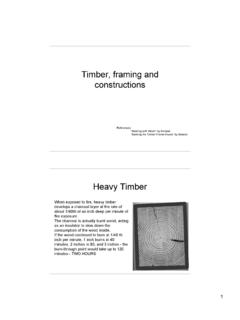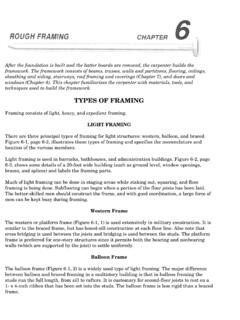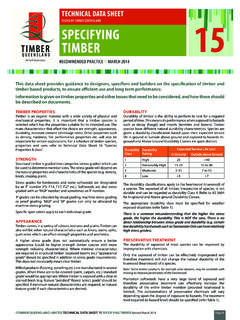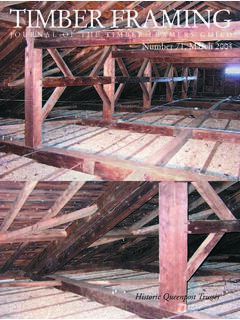Transcription of Timber Wall Framing. Studs are Consistently Placed @ 600 ...
1 Timber Wall Framing. Studs are Consistently Placed @ 600 centres with Nogs. Is this the most Efficient Arrangement? John Chapman, Chapman Ltd Consulting Engineers, Auckland, New Zealand Our company has been involved in structural design of domestic Timber since 1981. Over 90% of houses use 100*50 Studs @ 600 centres with 100*50 nogs @ 800c/c. This article considers the question should we continue with this pattern or should we be using Studs at 400. centres without nogs which is cheaper and quicker to construct? Comparisons are made under the following headings volume of Timber used; no of nails used; no of cuts made;. ability of walls to support sheet materials. It also briefly looks at the stance of NZS 3604 on the requirement of nogs and also the maximum stud heights allowed. NZS 3604 have taken into account typical combinations of vertical and horizontal loads on house framing. The specifications in the Winstones Gib Board Manual are considered. A previous article on this subject by the Forest Research in 1974 is briefly explained.
2 If there are no disadvantages in using Studs at 400c/c without nogs then perhaps we should seriously study this subject further to increase the viability and efficiency of using Timber framing. Figure is a photo of a flat addition with Studs constructed at 400 centres. Most of the Studs are external but some internal Studs are observable on the left of the photo. This framing is high. In the following comparisons the walls are high unless mentioned otherwise. The two types of walls are illustrated on figures 2. 1) Timber Volumes A) Studs at 600c/c Studs length = = nogs length = 2*1m = total length of framing Timber / m. of wall = B) Studs at 400c/c Studs length = = top &bottom plates = 2*1m = total length of framing Timber / m. of wall = wall B' uses 1% more wood than wall A'. 2) Framing Cuts (ignoring top and bottom plates, which are the same for both types of wall). A) Studs at 600c/c stud cuts = 2/.6 / K1 = nog cuts = 2*2/.6 /K2 = total cuts of framing Timber / m.
3 Of wall = B) Studs at 400c/c stud cuts = 2/.4 / K1 = total cuts of framing Timber / m. of wall = K1 and K2 above are deduced as follows.. If one half of the random lengths provide 2 Studs and one half of them provide 1 stud then there are 5 cuts per 3. Studs and K1 is (6 divided by 5). If all the nogs are made using one cut from spare Timber ' then K2 is 2. wall B' has 31% less cuts than wall A'. ISSUE 3 VOLUME 8 17 NZ Timber DESIGN JOURNAL. 3) Number of Nails (assuming 2 nails per joint). A) Studs at 600c/c Studs nails = 4/.6 = nogs nails = 4*2/.6 = total nails for framing Timber / m. of wall = B) Studs at 400c/c Studs nails = 4/.4 = total nails for framing Timber / m. of wall = wall B' has 50% less nails than wall A'. 4) Wall Strength (assuming internal and external wall linings exist which prevent buckling failure). There are 2 types of strength that are significant axial strength and bending strength. It is doubtful that shear strength of Studs for the purpose of domestic construction would be critical.
4 Axial loadings occur due to the gravity loads on the members being supported by the Studs . Bending is caused by face loadings on Studs . The most significant face loading would be wind. A) Studs at 600c/c No of Studs per m. = 1/.6 = B) Studs at 400c/c No of Studs per m. = 1/.4 = Wall B has 50% more strength than wall A'. 5) Support for Wall Linings (with the same bending strength in all directions). Plaster board and cement boards are examples of linings with isotropic properties. Table 1 applies the theory of virtual work to deduce the support for wall linings. The failure mechanisms are identified in figure 3. The ultimate face pressures are deduced as a function of the ultimate bending strength of the wall lining. The pressure at failure for Studs at 400centres is 22% more than for Studs at 600centres with nogs at 800centres. 6) New Zealand Building Codes Timber Framed Buildings - NZS 3604:1999 is the relevant building code. Studs are covered by section Maximum Allowable Stud Heights table of NZS 3604:1999.
5 Table is headed Studs in load bearing walls and floor loads . This table indicates the maximum allowable heights of Studs for various wind conditions, stud spacings, spans of members supported, and roof type (light or heavy). Table 2 of this article is a brief summary of table of NZS3604 and compares maximum allowable heights of Studs for 600mm and 400mm spacings. Studs at 400c/c can typically, according to NZS 3604, be used to greater height than those at 600 centres. Nogs as a Code Requirement section of NZS 3604. Section has the title Lateral support of Studs '. And states:- All Studs shall be laterally supported by either 3) Exterior wall claddings complying with section 11 or interior linings complying with section 12 .;. or 4) Dwangs, walings, or metal angle walings in accordance with Sections 11 and 12 allow for typical external and internal wall coverings including weatherboards, masonry veneers, solid plaster, plywoods, Timber fibre boards, profiled steel and zinc sections, profiled or flat fibre cement.
6 Thus, NZS 3604 concludes that for common building materials, which are fixed according to its recommendations, nogs are not required except for masonry veneer walls that are not lined on the inside. It could be argued that wall framing without nogs that is lined on one side only will not be as strong in bending under face loading when the unlined side is in compression. This is because the Studs in compression do not get lateral support from lining or nogs. ISSUE 3 VOLUME 8 18 NZ Timber DESIGN JOURNAL. 7) Gib Technical Manual' Specifications Winstones Wallboards Ltd publish the above manual, which specify nogs to be used in certain conditions. The Fire Rated Systems require nogs at 800 c/c maximum centres when their plasterboard is fixed with the sheets vertical and at 1200 c/c maximum centres when the sheets are Placed horizontally. The Gib Inter-Tenancy Noise Control Systems specify that nogs are needed at maximum centres. However Gib Bracing Systems consider Nogs are not considered to add to the bracing performance of the wall.
7 We contacted the technical department at Winstones Wallboards Ltd who explained the above nogs are specified because the walls used during their testing programs had nogs. The walls for testing the bracing systems did not contain nogs. They also said that gib board fixed horizontally needed a nog at the horizontals joints. However, we have recently observed on site horizontal joins in gib board connected differently. 200 high pieces of gib were glued to the top and bottom sheets at the horizontal join. The pieces of gib are long enough to fit neatly between the Studs and are glued half on to the top sheet and half on to the bottom. We revisited the site after plastering and painting and the finished product look flawless. 8) FRI Publication No12 April 1974 titled Are Dwangs Necessary In Timber Framed Walls During the writing of this present article I was sent this publication which examined the use of nogs under the following seven headings 1)Do dwangs make a wall stronger and stiffer?
8 2)Do they stop Studs from buckling? 3)Are they essential support ,with the Studs , for lining materials attached to the framework. 4) Do they prevent Studs distorting as they dry out? Are they needed for fixing household fittings to? Do they lessen fire risks within the wall? Do they prevent loss of heat? The conclusions to the above headings, in brief, are as below:- Tests showed that dwangs add little strength to help resist racking because methods of fixing them, either end nailing or skew nailing, do not produce rigid joints.. The horizontal dwangs can obviously do little to stop buckling inwards or outwards, and if a row of dwangs was to be effective against sideways buckling of Studs it would need to be restrained itself at either end of the wall.. In fact, a wall frame with Studs 400 mm apart and no dwangs gave slightly better support than one with Studs 460 mm apart with three rows of dwangs.. Crook, or bending out from the frame, serious. Dwangs are unlikely to have much effect because, although tightly fitted initially, they may become loose as Studs shrink.
9 Cladding materials are better for restraining this type of distortion.. Dwangs are obviously suitable for fixing such essentials as kitchen and bathroom fittings. It would be more economic, however, to insert them at the required height in the required place.. Blocking off of electrical outlets and potential sources of fire could do the same job without the expense of inserting rows of dwangs in all walls.. In a wall which is insulated . they act as bridges and may encourage heat to escape.. The conclusions of the FRI article include: Dwangs in lined buildings need be used only for Supporting linings in places where damage is likely Fixing household fittings Blocking off potential fire hazards in the wall Wider use than this, it cannot be justified on technical grounds, seems a waste of time, material, and labour. The Timber engineers are not alone in reaching this conclusion. Canada, the United States, and the United Kingdom do not recommend the use of dwangs where Studs are spaced up to 600mm apart, except for one row in unlined walls under heavy load and as localised lining support.
10 ISSUE 3 VOLUME 8 19 NZ Timber DESIGN JOURNAL. 9) Conclusions In the categories considered above Studs spaced at 600centres are less efficient than those spaced at 400centres, except for the 1% difference in Timber volume. The main reasons that I have heard of for using nogs are that they absorb the short ends of Timber , which reduces wastage, and they help prevent Studs from buckling on drying. These reasons are not so relevant for dry framing. At present dry frame can be bought in cut lengths at the same price as random lengths. Thus a house lot of Studs can be ordered with no wastage at all. The main advantages of Studs at 400 centres are that the number of stud/nog cuts is reduced by 31% and the number of nails in the frame is reduced by 50%. Before placing linings Timber framing in New Zealand is usually wetted by showers which can lead to a small percentage of Studs twisting and buckling. Some builders replace these out of shape Studs just before applying the external cladding.





